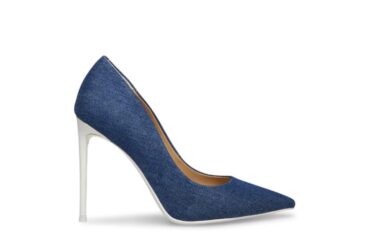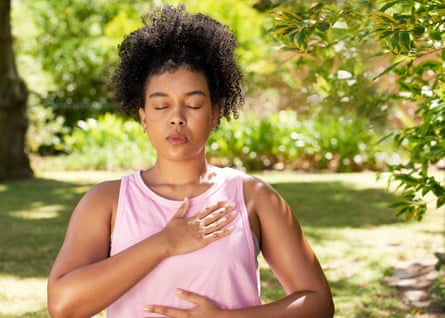
Don’t take this the wrong way, but let’s imagine you are heading into 2024 at fitness ground zero: on to a medium to low baseline, you have heaped a month of doing nothing at all. What can you do to return to fighting form as painlessly as possible? Well, a lot – though, I warn you, it will take time.
This 12-month programme starts easily enough, but by December you should have found at least a few activities that really stretch you, or that don’t immediately appeal. Don’t write them off. The best gestalt fitness advice I ever heard came from an Australian tennis coach, who said: “Whatever you’re doing, you need to introduce an activity at which you are not adept.”
That said, no one is expecting you to stick with every exercise as the year goes by. How would you find the time to work and sleep? But at the very least you want to end up doing something aerobic, such as running or swimming; something to build muscle, such as weight training; and something that increases flexibility, such as yoga or pilates.
I got expert advice from Lucinda Meade, a 59-year-old physiotherapist and personal trainer whose fixations (muscle preservation, bone density, menopause, living your best life till you die) align with mine, but all of this should work whatever your age.
January: walking
Public Health England is obsessed with the 10-minute daily brisk walk: from a whole population perspective, this is the most bang you’ll ever get for your buck. I suggest an 18- to 19-minute variation: go out of your house, walk for 10 minutes in any direction, then try to get home quicker than that. It’s very simple, a little gamified, and basically impossible to fail. Do this daily and introduce minor challenges, such as walking on uneven ground, or going uphill. Head out early: you need the best possible daylight for mood purposes.
The walking technique guru is Joanna Hall (who has a coaching app); she would tell you to be aware of how you are planting your feet, concentrating on the articulation of your back foot. Lift from your hip, and don’t bob your head forward. Imagine yourself wearing long drop earrings that you want everyone to see, is her advice. Weirdly, this really works.
February: breathwork
In the 70s, Stanislav Grof pioneered “holotropic” breathing, which he said could give you a trippy, LSD-high. This might not be what you’re after, but it does scope out the possibilities of breathwork, which can be quite an intense experience, taking you to the edge of where your body and your consciousness collide. But you don’t have to do it like that; the first time I tried it was with an executive coach, who taught me how to dynamic breathe before a meeting. You inhale sharply like an appalled Miss Jean Brodie, then exhale softly. Ultimately I got on better with a YouTube surfer breather called Sandy.
Meade describes a number of techniques – “hyperventilation, relaxed breathing, meditation” – that, once you’ve got them, will “benefit you in every way. Your stress levels will go down, you’ll sleep better, you’ll lose weight, you’ll get rid of all the toxins – everything will just work better.” The NHS website has a very simple breathing exercise; Jesse Coomer’s book A Practical Guide to Breathwork is a fuller physiological inquiry and very plausible. He’s also on Instagram.
March: circuits
Between the walking and the newfound groundedness, you’ll be ready for something that makes you sweat. The thing with circuits, if you are doing them right, is that the whole hour is challenging and tiring. Some people can induce that commitment in themselves; most of us need the peer pressure that comes from doing a class.
The trend over the past five years has been either for a club-like atmosphere – dark, loud, frenetic, a 50:50 cardio/strength split, where even the weights are done very fast – or for a quasi-military, outdoor workout, which tends to be a little cheaper. The promised calorie burn is incredible – the gym-based classes routinely vaunt 1,000+ calories per 50 minutes, which I’m not sure I believe, but you definitely end up feeling depleted (in a good way). The best single piece of advice for maintenance? Don’t shop around: choose a class and stick with it. The other people are most of the point.
April: reformer pilates
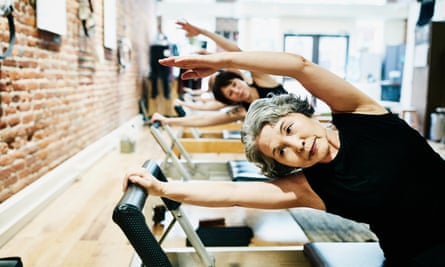
Pilates is a strength and flexibility discipline; the movements are repetitive and sometimes minute. Reformer pilates is done on a bench, with springs at one end to manage the resistance and straps at the other for arm work. You might be lying down on it, standing up, pushing the bench in and out with your arms or legs; whichever way, you’re working muscle tone, balance and flexibility in a very low-impact way, so it’s all-ages and great after injury.
Because of all the equipment and the small class size, this really isn’t cheap: the best place I’ve tried, I could not afford. But look for deals because studios are everywhere and some are really good value. Once you have sorted your technique in a class, you can probably move to mat pilates at home, and find moves and routines on Instagram.
May: weight training
“As you get older, there is no other way, in a relatively short time, to build muscle,” Meade says. “It’s wasting away after you’re 40, unless you’re a builder.” As your muscles get weaker your posture will deteriorate, which is very ageing of itself, and your bones will become more vulnerable, which means more injury, more pain.
Anna Jenkins does online coaching at Wafa – We Are Fit Attitude, a health and fitness club aimed at women aged between 40 and 60, and the members are evangelical. You will need kettle bells and resistance bands in the first instance. Probably, as you get more obsessive, you’ll find yourself in possession of a full set of weights.
Personally, I’d just go to a “pump” class in your local authority gym. They’re really fun, and you get to hear the club toons all the young people are listening to.
June: running
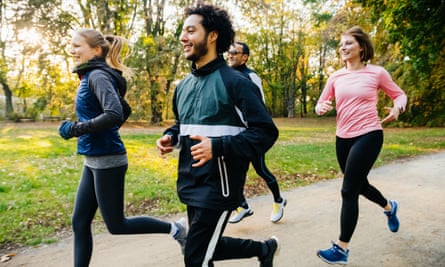
Ah, Couch to 5k, then back to couch again. Hello old friend: I’ve sure been here a lot of times, gingerly running for 90 seconds, feeling as if my lungs were going to explode, before steadily working up to a respectable 25 minutes. It’s free, it’s low drama, zero interaction, and it works. No wonder so many people end up only running.
Try not to do too much, too fast. “Listen to your body,” Meade says. “What’s the pain of muscles working, and what’s the pain that isn’t good?” You’re starting in June not only for the weather, but because you need to have built up your strength first. “People injure themselves because they’ve got good lungs but they’re weak, so they push themselves but then fall to pieces,” Meade says. You need a plan for when you achieve 5k, otherwise, high on self-love, you’ll give up. Sign up to an organised 10k.
July: swimming
Swimming is an incredibly good exercise for the low-impact use of every single muscle, and once you have a swim-ethic there’s no reason you have to stop doing it. You’ll rarely get injured. However, if the smell and harsh echoes of a municipal pool unearth terrible childhood memories of being too cold and not being allowed to go to the vending machine afterwards, it will help to start outdoors.
I went lido swimming with the swimmer and writer Becky Horsbrugh, who said the following: “If you’re intimidated by the water, spend your first few minutes of every session just floating. Once you understand your natural buoyancy, it will give you confidence.” Swimming outdoors has massive cold water benefits, even in summer. Wild-water swimming is good for the soul, and people who take up long-distance swimming experience it as a whole new chapter of life, with managed jeopardy and increased prowess combining to rejuvenate even the most jaded old campaigner.
August: yoga
It is holiday season, and you need something you can take away with you that doesn’t rely on a fixed routine. Do start with a couple of lessons so you’re doing it right, and choose your style: ashtanga is the fast-paced, shape-throwing one; hatha is the contemplative, sustained posture one; the fashionable class at the moment is vinyasa flow. Note: if the idea of sitting still and holding a pose fills you with dread, that’s probably the one you should be doing.
Once you have perfected or at least found relative confidence in your practice, you can just carve out 20 minutes at home, either with a YouTube tutorial (Adriene Mishler is the global leader, and for a reason: she is good, calm and free) or by building a self-practice according to the fundamental basics: include all the movements of your spine (rotation; twists; elongation), then add in balance (standing poses) and coordination (cross-lateral movements).
September: bouldering or parkour
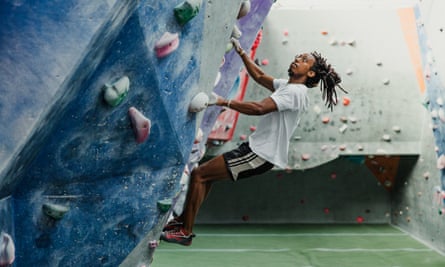
You’ve got to autumn, you’re a whole new you, and you want something to show for it, something cool. Also, to go back to the first principle, something at which you are completely incompetent, which will challenge bits of your body you didn’t know you had.
Bouldering is really hip, has great progression – the green grades a child could do; the white ones feel as if they might kill you – and unlike roped climbing, doesn’t need a lot of expertise or a partner before you can start. It has a puzzle logic to it, so there’s a lot of mental satisfaction too. It’s quite expensive, though, and I never found a way to get the price down (it’s so popular, a lot of climbing centres don’t even have an off-peak).
Parkour, meanwhile, may entail an initial coaching outlay, but sooner or later you could do it on your own, for free. It’s exhilarating but you will feel the concrete in your ancient bones if you haven’t built up your muscles ahead.
October: fell running
Again, this is a show-off sport for the purposes of self-congratulation, and this month has the year’s last trace of daylight, so use it wisely. It helps to live in the right bit of the country: there are active fell running scenes in Sheffield and the Isle of Wight; in south London, not so much.
It’s great cardio and it tends to be low-impact because you’re not on pavement. It also frees your mind from the relentless smartwatch-measuring of speed and distance; the terrain is too varied, and at times too challenging, to get hung up on that stuff.
Even though the uphill is what will kill you, the down is where you will fall over. Ideally, you will have used all that walking to improve the mobility and strength in your feet and ankles, so you won’t get sprains. Don’t feel bad about being the novice in a club. That one guy who looks as if he’s ruining his own run to help you out: he isn’t – he lives for this moment.
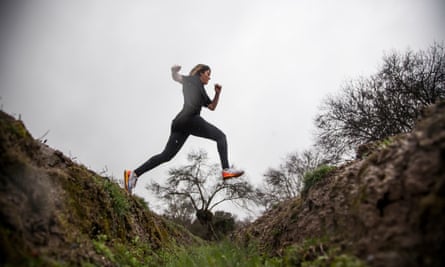
November: natural movement
There are gyms that will do natural movement classes – they tend to be shorter, 20-minute bursts, and they are sometimes called functional movement – but essentially, you’re trying to extend your strength training, which may have become a little perfunctory or instinctive, with unfamiliar moves. Meade describes these as “crawling and jumping, bear crawls, kneeling to tall kneeling”. If you imagine the things that toddlers do just to mess about, you’re in the right zone. The internet is lousy with natural movement regimes, which, unlike traditional weight-bearing exercises, are almost impossible to mess up.
The point is to bring your strength and flexibility simultaneously to bear, so you are not trading off between one and the other. A lot of it will feel awkward and unfamiliar, which is part of the point. With balance especially, you have to almost lose it to get the benefit.
December: aerial yoga or pilates
In aerial pilates and yoga, you have an individual silk (it’s really more like a big bit of jersey) that hangs in a loop from the ceiling and works like a hammock. Whether you are swinging on it, cocooned in it, or hanging upside down walking your hands across the floor, you are very stable. I’ve never seen anyone fall off or out of a silk. Have a look at @theakingmovement on Instagram for a demo. Essentially, you’re doing resistance and strength work acrobatically, and at a weird angle: you might be doing a pull-up, but with your feet in the silk and your whole body in the air it looks harder than it is and immensely cool. There’s a huge sense of play, and the unfamiliarity of the movements makes you work harder instinctively. You’ll need a class, obviously – it’s quite a commitment to install silks in your own house, plus what would the neighbours think?



